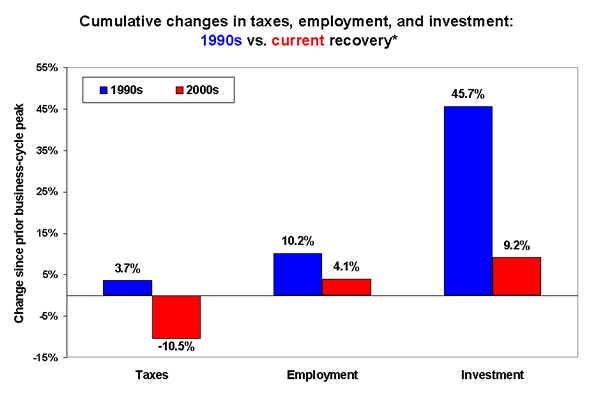See Snapshots archive.
Snapshot for August 22, 2007.
Tax cuts, investment, and employment: The evidence contradicts supply-siders
by Josh Bivens and Jared Bernstein
One of the most frequently heard phrases in certain Washington policy circles is “the tax cuts are working.” As President Bush put it just last week, “Since the tax cuts took full effect in 2003, our economy has added more than 8.3 million new jobs.”
The logic behind this claim falls under the rubric of “supply-side economics.” The basic idea is that taxes constrain investment and employment growth. So if taxes are cut, by this logic one expects investment and employment would grow more quickly. This mobilization of investment and labor in turn would generate faster overall growth. Extreme forms of supply-side arguments assert that the extra growth results in a surge of government revenue large enough to allow the tax cuts to “pay for themselves.”
The changes to the tax code in the 1990s and 2000s provide a good opportunity to see if these broad predictions hold up to the evidence. The figure below examines investment, employment, and tax changes (cuts in 2000s and increases in 1990s) over the first six years of these two recoveries.

Contrary to supply-side arguments, both investment and employment grew considerably faster in the 1990s, when tax increases raised revenue, compared to the 2000s, when the tax cuts lowered revenue. Investment grew 35% more quickly in the 1990s, and employment grew 6% faster. Of course, there are always many different factors driving investment and employment, none of which are controlled for in this analysis. But the data clearly refute the simplistic notion that the tax cuts of the 2000s boosted investment or job growth.
Data Note: Data from first 26 quarters of each recovery. Data on tax changes from Citizens for Tax Justice; data on investment from the Bureau of Economic Analysis (BEA); data on employment from the Bureau of Labor Statistics. Tax changes are expressed as shares of gross domestic product (GDP); investment and employment changes are expressed as percentage changes. All variables are measured from the previous business-cycle peak.
